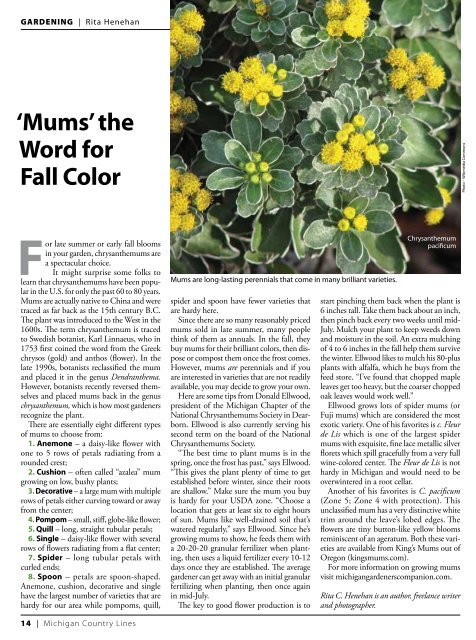Cherryland Electric Cooperative - Michigan Country Lines Magazine
Cherryland Electric Cooperative - Michigan Country Lines Magazine
Cherryland Electric Cooperative - Michigan Country Lines Magazine
Create successful ePaper yourself
Turn your PDF publications into a flip-book with our unique Google optimized e-Paper software.
GARDENING | Rita Henehan<br />
‘Mums’ the<br />
Word for<br />
Fall Color<br />
Photo – Wikimedia Commons<br />
For late summer or early fall blooms<br />
in your garden, chrysanthemums are<br />
a spectacular choice.<br />
It might surprise some folks to<br />
learn that chrysanthemums have been popular<br />
in the U.S. for only the past 60 to 80 years.<br />
Mums are actually native to China and were<br />
traced as far back as the 15th century B.C.<br />
The plant was introduced to the West in the<br />
1600s. The term chrysanthemum is traced<br />
to Swedish botanist, Karl Linnaeus, who in<br />
1753 first coined the word from the Greek<br />
chrysos (gold) and anthos (flower). In the<br />
late 1990s, botanists reclassified the mum<br />
and placed it in the genus Dendranthema.<br />
However, botanists recently reversed themselves<br />
and placed mums back in the genus<br />
chrysanthemum, which is how most gardeners<br />
recognize the plant.<br />
There are essentially eight different types<br />
of mums to choose from:<br />
1. Anemone – a daisy-like flower with<br />
one to 5 rows of petals radiating from a<br />
rounded crest;<br />
2. Cushion – often called “azalea” mum<br />
growing on low, bushy plants;<br />
3. Decorative – a large mum with multiple<br />
rows of petals either curving toward or away<br />
from the center;<br />
4. Pompom – small, stiff, globe-like flower;<br />
5. Quill – long, straight tubular petals;<br />
6. Single – daisy-like flower with several<br />
rows of flowers radiating from a flat center;<br />
7. Spider – long tubular petals with<br />
curled ends;<br />
8. Spoon – petals are spoon-shaped.<br />
Anemone, cushion, decorative and single<br />
have the largest number of varieties that are<br />
hardy for our area while pompoms, quill,<br />
Mums are long-lasting perennials that come in many brilliant varieties.<br />
spider and spoon have fewer varieties that<br />
are hardy here.<br />
Since there are so many reasonably priced<br />
mums sold in late summer, many people<br />
think of them as annuals. In the fall, they<br />
buy mums for their brilliant colors, then dispose<br />
or compost them once the frost comes.<br />
However, mums are perennials and if you<br />
are interested in varieties that are not readily<br />
available, you may decide to grow your own.<br />
Here are some tips from Donald Ellwood,<br />
president of the <strong>Michigan</strong> Chapter of the<br />
National Chrysanthemums Society in Dearborn.<br />
Ellwood is also currently serving his<br />
second term on the board of the National<br />
Chrysanthemums Society.<br />
“The best time to plant mums is in the<br />
spring, once the frost has past,” says Ellwood.<br />
“This gives the plant plenty of time to get<br />
established before winter, since their roots<br />
are shallow.” Make sure the mum you buy<br />
is hardy for your USDA zone. “Choose a<br />
location that gets at least six to eight hours<br />
of sun. Mums like well-drained soil that’s<br />
watered regularly,” says Ellwood. Since he’s<br />
growing mums to show, he feeds them with<br />
a 20-20-20 granular fertilizer when planting,<br />
then uses a liquid fertilizer every 10-12<br />
days once they are established. The average<br />
gardener can get away with an initial granular<br />
fertilizing when planting, then once again<br />
in mid-July.<br />
The key to good flower production is to<br />
Chrysanthemum<br />
pacificum<br />
start pinching them back when the plant is<br />
6 inches tall. Take them back about an inch,<br />
then pinch back every two weeks until mid-<br />
July. Mulch your plant to keep weeds down<br />
and moisture in the soil. An extra mulching<br />
of 4 to 6 inches in the fall help them survive<br />
the winter. Ellwood likes to mulch his 80-plus<br />
plants with alfalfa, which he buys from the<br />
feed store. “I’ve found that chopped maple<br />
leaves get too heavy, but the coarser chopped<br />
oak leaves would work well.”<br />
Ellwood grows lots of spider mums (or<br />
Fuji mums) which are considered the most<br />
exotic variety. One of his favorites is c. Fleur<br />
de Lis which is one of the largest spider<br />
mums with exquisite, fine lace metallic silver<br />
florets which spill gracefully from a very full<br />
wine-colored center. The Fleur de Lis is not<br />
hardy in <strong>Michigan</strong> and would need to be<br />
overwintered in a root cellar.<br />
Another of his favorites is C. pacificum<br />
(Zone 5; Zone 4 with protection). This<br />
unclassified mum has a very distinctive white<br />
trim around the leave’s lobed edges. The<br />
flowers are tiny button-like yellow blooms<br />
reminiscent of an ageratum. Both these varieties<br />
are available from King’s Mums out of<br />
Oregon (kingsmums.com).<br />
For more information on growing mums<br />
visit michigangardenerscompanion.com.<br />
Rita C. Henehan is an author, freelance writer<br />
and photographer.<br />
14 | <strong>Michigan</strong> <strong>Country</strong> <strong>Lines</strong>

















